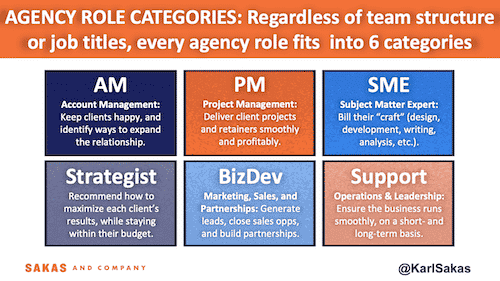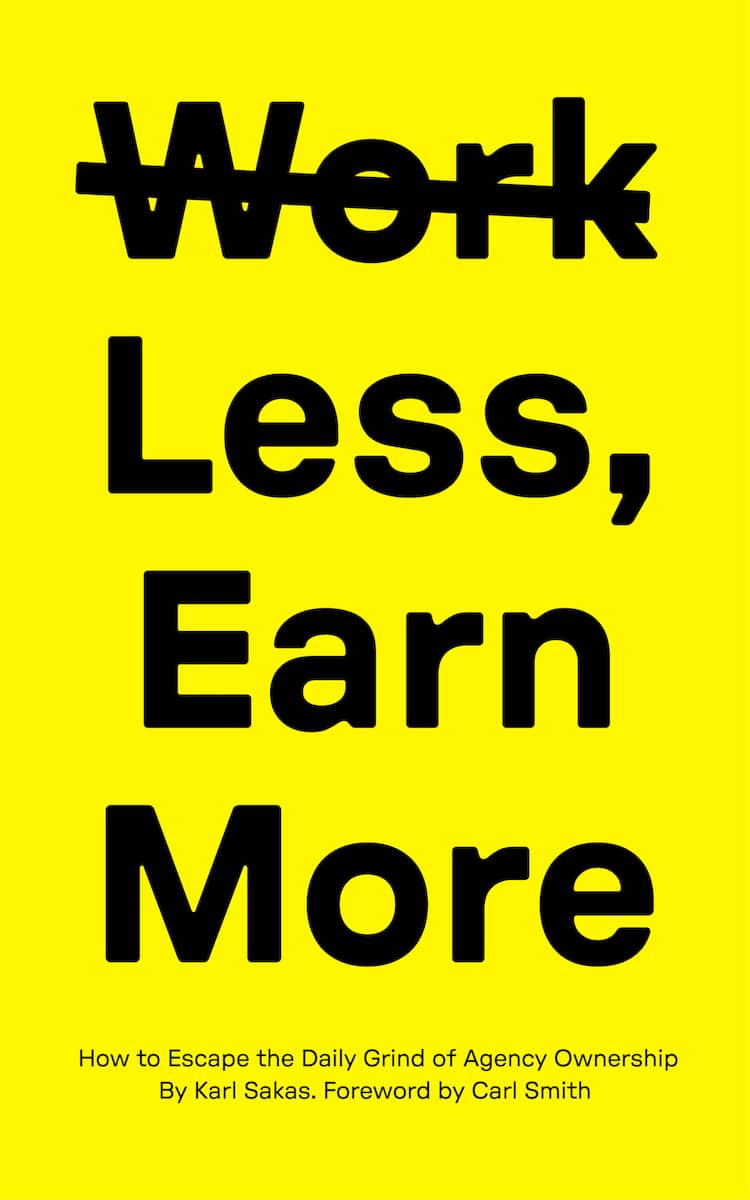
[Click to zoom] Agency roles fit into 6 categories: AM, PM, SME, Strategist, BizDev, and Support.
Once you understand the foundational roles, everything about running your agency gets easier—you can create the right jobs, hire the right people, communicate internally and externally, and manage your team for better results. Ultimately, knowing—and acting on—my six-category framework will help you make your agency more profitable.
Today, let’s review my six categories—including definitions, common job titles, and a preview of billable targets. By the end of this article, you’ll have a clearer view into potential blind spots, so you can start making improvements. If you get stuck—or you want an expert opinion to confirm you’re on the right track—contact me for help. I have a range of options to fit most budgets, including my bite-size consulting calls.
In a series of future articles, I’ll review how to customize billable targets, how to combine multiple roles without creating new problems, and where agency owners should focus to see the strongest ROI on time. Don’t miss out—subscribe to my newsletter to get updates when the followups go live.
My Six-Role Framework: What are the six Agency Role categories?
Every agency position fits into at least one of these six categories:
- Account Management (AM)
- Project Management (PM)
- Subject Matter Expert (SME)
- Client Strategist
- Business Development (BizDev)
- Support
What does each category mean? Read on for definitions—and a preview of billable targets.
What’s the definition of each role?
Some people at your agency may wear several hats, as they perform more than one role at once. My definitions assume a single focus, but I recognize that multi-role employees may wear 2-3 hats; if that applies to your agency, you’ll mix-and-match the responsibilities.
Account Management (AM)
Account Management (AM) is about keeping clients happy (and, typically, upselling them more work). This includes a focus on client retention, as well as onboarding new clients. They are the voice of the client within the agency, ensuring the client is getting their needs met (although this sometimes leads to a well-meaning AM acting against the agency’s interests).
Typical AM job titles include Account Manager, Account Director, Account Coordinator, and Account Specialist (although at some agencies, a “Project Manager” is more AM than PM). Sometimes an Account Director fits my AM category—but more often, it’s a veiled “salesperson” title (and appears in BizDev, below).
I recommend an AM minimum billable target of 50%+ (that is, 20+ hours a week). They’ll spend the rest of their time on non-billable relationship-building, upsells, and (at some agencies) outright sales. For more on sales, see the BizDev category below.
Project Management (PM)
Project Management (PM) is about completing work smoothly and profitably. They crack the whip to get things done, primarily focused on the internal team. “Project” is a misnomer; PMs can work on retainers and other recurring revenue, too. And at many agencies—especially smaller firms—PMs are client-facing, too.
Typical PM job titles include Project Manager, Project Coordinator, Producer, Traffic Manager, Resource Manager, and Director of PM. Some PMs tend to do some non-billable Support work, too, around operations—especially if they’re serving as a Resource Manager. Be sure to find the right level of PM expertise.
I recommend a PM minimum billable target of 50% (that is, 20+ hours a week). They’ll spend their non-billable time on building internal processes, creating documentation, supporting sales estimates and proposals, and dealing with the overhead of “switching costs” as they shift between billable work.
Subject Matter Expert (SME): Design, Development, Writing, Analysis, etc.
Subject Matter Expert (SME) is about practicing their highly billable “craft.” They’re an expert in one or more areas, and their ideal day has them doing that thing (their craft) all day long.
Although unique to each agency (and the services the agency provides to clients), typical SME job titles include Designer, Developer, Copywriter, Analyst, Specialist, and QA Technician.
Strategists (below) are a special type of SME that’s highly client-facing. Creative Directors, Art Directors, and Technical Directors are each SMEs who have billable-reducing managerial (and sometimes Sales Support) responsibilities.
Because AMs and PMs are ideally “protecting” SMEs from client interruptions, your SMEs are ideally billing 75-85% of their time (that is, 30-32 hours a week). I often see variations:
- An SME who also handles AM or PM will be lower, perhaps 60-70% billable. And a purely back-end SME (for instance, a developer or production designer who never talks to clients) could be 85-90% (32-36 hours a week), but that’s rare.
- If an SME is a Team Lead (a senior team member who mentors and sometimes oversees other SMEs without being a pure manager), they’ll have a somewhat lower billable target (since their job is to optimize others’ billable time).
Speaking of client strategy…
Client Strategist
Client Strategist is about directing your agency to meet the client’s goals, by spending a client’s budget on the highest-ROI activities. They’re technically an SME (in the sense that they’d ideally do strategy—their “craft”—all day long). But since that necessarily requires client contact, think of strategists as a mix of SME and AM.
Typical Client Strategist job titles include Strategist, Director of Strategy, and VP of Strategy. Be sure to “insulate” strategists from day-to-day client contact (via the AM and/or PM), since clients love talking to good strategists. That’s fine if it meets the agency’s needs… but not when the strategist needs to be heads-down (especially if they need to be heads-down on a different client). Strategists typically served in another SME role before pursuing strategy. See my advice on promoting strategists from within.
Depending on how you’ve structured their role, a strategist’s billable target will be somewhere between an AM and a pure SME—typically billing 60-75% (24-30 hours a week). Their non-billable time includes sales support, self-marketing support, and training other team members (including SMEs, AMs, and salespeople) on relevant trends. If the “strategist” is actually a salesperson, they’re technically within the non-billable Biz Dev category (below).
Business Development (BizDev): Marketing, Sales, and Partnerships
BizDev is about generating leads, working and closing sales opportunities, and building partnerships—various types of “business-building” work to bring in the billables that other team members ultimately fulfill. They’re your internal self-marketers, salespeople, and (at some agencies) partnership managers.
At agencies, typical BizDev job titles include Director of Marketing, Marketing Manager, Business Development Representative, Account Executive, VP of Growth, and Partnerships Manager.
Your BizDev people are typically 0% billable, although smaller agencies tend to have an otherwise-billable person lead self-marketing (or vice versa, pulling a billable person into doing self-marketing). At many agencies, the “Director of Marketing” is at least partially client-billable. And sometimes Account Managers have a sales quota, too.
Support: Operations & Agency Leadership
Support is about making agency operations run smoothly—on both a short- and long-term basis. Your Support team makes life easier for your billable team members, ensures you stay profitable, and ensures clients pay on time.
Typical Support job titles include Executive Assistant, Office Manager, Operations Manager, Director of People, Director of Operations, and Chief Operating Officer (COO). As you grow, agency owners tend to expand their Support-related role, around business strategy for the agency itself.
Your agency’s Support people are typically 0% billable, although I’ll sometimes see 5-10% billable if a Support person is helping the delivery team with Quality Assurance (QA). Related, a Resource Manager will be at least partially-billable when they coordinate people for billable work.
Leadership-wise, it helps to have a strong #2. Need to hire someone as your right-hand person? See my articles on the topic.
What else should we consider about Agency Roles?
In a future article, I’ll review why there isn’t an “Agency Owner” role category, how to customize the Billable Hours target for each role, and how to successfully split or combine roles to meet your agency’s needs. Don’t miss the updates—subscribe to my newsletter to hear when they go live.
In the meantime:
- Start by doing an “inventory” of the roles at your agency. Who’s doing what? Are there any roles where it’s unclear who’s in charge? How many people are doing more than one role? Is anyone doing more than 2-3 roles?
- Think about how you might split or shift roles, especially where you notice current gaps. For instance, if you like client strategy but don’t like being the client’s day-to-day contact, you’ll need to recruit someone to handle AM. If the person doing PM isn’t detail-oriented, you’ll want to shift that to someone who is (whether a current team member or a future hire).
- Review how your team structure needs to change as you grow. The structure that worked a year ago likely won’t work a year from now… and it may not be working today. Understanding the six roles will help you see what needs to shift, to help you make the agency serve you.
If you get stuck—or you want an expert opinion to confirm you’re on the right track—contact me for help. I have a range of options to fit most budgets.
Question: How is your agency currently handling the six role categories (AM, PM, SME, Strategist, BizDev, and Support)—and what needs to shift to meet your future goals?


